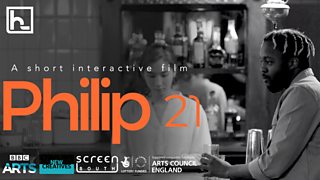Philip 21 - an interactive story exploring race, love and modern Britain
Joey Amoah
Development Producer
Philip 21 is a brand new narrative object-based media (OBM) experience from that takes the premise of a date with a young black man and turns it into an introspective examination of race, love and modern Britain. In this blog post, we look at the techniques and mechanics that underpin this and other branching narrative experiences, examining how they keep audiences engaged compared to traditional media.
In this regard, two specific areas of the project need to be examined; the fabula and syzhuet of the authored experience; and the dual narrative created by having the outcome of the story that each audience member sees be dependent on the choices they make.

The 'fabula' is a literary term used to refer to the raw material of a story, what takes place and the chronology of events. It describes the skeleton of the experience, story beats and the audience journey. The 'syzhuet' describes how the story is organised and presented to audiences. It covers everything from the perspective the story is told from to the arrangement of actors and the cinematography of a scene.
In traditional media, the audience is passive and cannot interact with what is being shown. Storytellers may play with the audience journey and how the story is presented, but they never surrender control of the constituent elements, and they do not offer alternative and equally valid branches. halucid_ have had to wrestle with the challenge of making the fabula and syzhuet work together while also giving up a degree of creative control.
The fabula and syzhuet of the authored experience
In the case of Philip 21, the fabula could be described as being broadly linear. The audience arrives for a date with Philip; they engage in conversation with him and are ultimately asked if they would like a second date or not. However, this simple sequence is not what is received by the audience. What does take place is a fragmented series of scenes where progress can only be made through user choices and engagement. halucid_ plays with the fabula and utilises the narrative setting, the conversational structure and the first-person perspective to drive the experience forward. Philip 21 takes the narrative setting, that of a date, and uses it to establish the boundaries of the world and to inform us on how we should behave. Since many of us will be familiar with this experience from our own lives, halucid_ leans on the understanding of social norms to get audiences to participate in the way that they desire. Building on this, halucid_ uses the codes and conventions of conversations to create an internal metre that demands our engagement. It is only through responding to Philip’s questions and internalising his responses that the narrative can advance. In so doing, it bids the viewer to suspend their disbelief and enter into the story world. Finally, the first-person perspective means that the audience is always focused on the subject, unable to look away, and the fixed camera position creates a sense of intensity, intimacy and immediacy, which is further heightened by the one-to-one interaction enjoyed with Philip.
These creative decisions help move the narrative forward and straddle the line between the fabula and how the authored experienced is presented. This is particularly important to the narrative OBM experience because both content creators and audiences are jointly responsible.
Philip 21 can be navigated in several different ways, with each choice offering a different route through the experience. These routes have been created by halucid_, but audiences have the freedom to select which paths to follow. They can choose a path from the outset or change course at any point, meaning that the syzhuet presented is unique to each viewer. Philip 21 has no primary path, and as a result, all routes through the experience and all outcomes received are equally valid.
The dual narrative
The second interesting element worthy of discussion about Philip 21 is how it goes about creating a dual narrative. On the one hand, Philip 21 is an authored experience, a story that halucid_ is seeking to tell, and on the other, there is the audience experience and what the audience bring and take away from the experience. The audience is integral to delivering Philip 21, and by taking part, they are positioned not as passive watchers but are co-protagonist alongside Philip. The viewer becomes a character in the story and must decide how to approach the situations in the story.

(Jason Dodd Photography)
The viewer must decide if they will approach the work sincerely as their authentic self or assume a persona/play a role that goes against type. This choice, whether conscious or unconscious, determines where the story goes. This way, what is presented back to the audience is a reflection of choices made. Philip 21 could be considered as having two narratives. The authored story and one reflected to the audience based on how they interact with the experience.
What comes next
Narrative OBM experiences are still in their infancy, and we are only beginning to understand the impact of content creators giving over control to audiences. Altering the syzhuet of a story presents a wide array of creative opportunities for creators and audiences, but these choices will need to work in tandem with the fabula and not distract from the story. We are unsure of what works best and are eager to see further experiments in this area.
Likewise, the interplay between the authored experience and the one reflected back at audiences is something we are keen to explore in more detail. What would happen if additional choices were offered to audiences? What would occur if a story was told episodically and not in one session? How would audiences experience this? The only way to find out is to build and test these kinds of experiences.
